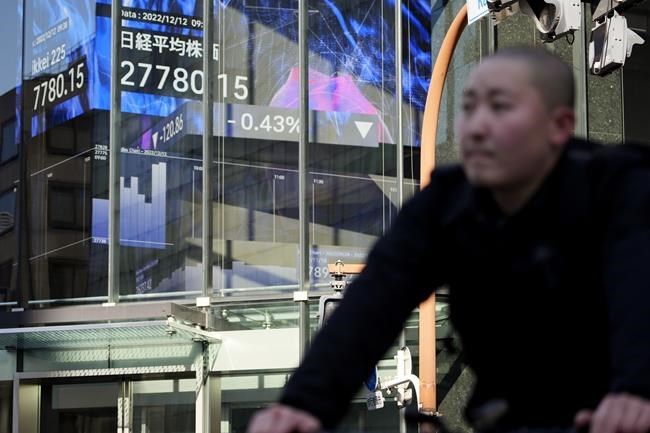NEW YORK ŌĆö Stocks are closing higher on Wall Street at the start of a busy week where central banks are likely to unload the yearŌĆÖs final barrage of interest rate hikes. The S&P 500 rallied 1.4% Monday. On Wednesday, markets expect the Federal Reserve to announce a more modest increase to rates than it has been pushing through recently. Other central banks around the world are also expected to raise rates by half a percentage this week, including EuropeŌĆÖs. Higher rates slow the economy and risk causing a recession if they go too high, all while dragging down prices of investments.
THIS IS A BREAKING NEWS UPDATE. APŌĆÖs earlier story follows below.
Wall Street is rising Monday to open a week where central banks are likely to unload the yearŌĆÖs final barrage of interest-rate hikes meant to drive down the worldŌĆÖs painfully high inflation.
The S&P 500 was 0.7% higher in afternoon trading, trimming its loss for the year to 16.9%. The Dow Jones Industrial Average was up 296 points, or 0.9%, at 33,771, as of 2:49 p.m. Eastern time, and the Nasdaq composite was 0.5% higher. The indexes are coming off their first weekly loss in three weeks.
The main reasons for Wall StreetŌĆÖs struggles for much of this year have been high inflation and the higher interest rates engineered to combat it. On Wednesday, markets expect the Federal Reserve to announce its last rate hike of the year following a blitzkrieg that began in March.
Higher rates slow the economy by design and risk causing a recession if they go too high, all while dragging down prices of investments. One upside for investors is that the Fed has hinted it will dial down the size of its rate hikes, leading to expectations for a more modest increase of 0.50 percentage points Wednesday.
That would follow four straight mega-hikes of 0.75 percentage points. Each was triple the Fed's usual move, and they lifted the central bank's key overnight rate to a range of 3.75% to 4% after starting the year at virtually zero.
Other central banks around the world are also likely to raise their own rates by half a percentage point this week, including the European Central Bank.
Any dial down in the size of rate hikes would mean less added pain for markets and the economy. Such hopes have helped stocks and bonds rally since mid-October, as investors have taken data reports to mean the worst of inflation has finally passed and would allow the Fed to ease up.
But expectations for a slowdown in rate hikes may also be setting some investors up for disappointment, if central banks signal this week theyŌĆÖll ultimately take rates higher than markets expect. While they arenŌĆÖt the clear majority of the market, many traders are betting the FedŌĆÖs overnight interest rate will top out at a range of 4.75% to 5% next year, for example.
Economists at Goldman Sachs expect Fed policy makers on Wednesday to signal their median expectation is for rates to hit a range of 5% to 5.25%, up by half a percentage point from their last projection.
Some investors also continue to make moves in anticipation of the Fed cutting interest rates during the second half of 2023. Rate cuts generally act like steroids for stocks and other investments, but the Fed has been insisting it plans to hold rates at a high level for some time to ensure the battle against inflation is won.
Even if inflation is indeed on its way down, the global economy still faces threats from the rate increases already pushed through. The housing industry and other businesses that rely on low interest rates have shown particular weakness, and worries are rising about the strength of corporate profits broadly.
ŌĆ£Inflation Data and Fed Is YesterdayŌĆÖs News; Focus on Earnings RiskŌĆØ was the title of a report published Monday by strategists at Morgan Stanley.
The next big milestone for markets comes Tuesday, when the U.S. government releases the latest update on inflation at the consumer level. Economists forecast that inflation slowed to 7.3% last month from 7.7% in October. The data will arrive as the Fed begins its two-day policy meeting on what to do with interest rates.
Besides raising short-term rates, the Fed is also making other moves with its vast trove of bond investments that should effectively allow longer-term yields to rise.
The yield on the 10-year Treasury, which helps set and other economy-setting loans, rose to 3.61% from 3.59% late Friday. The two-year yield, which tends to more closely track expectations for the Fed, rose to 4.39% from 4.34%.
In overseas stock markets, Asian indexes fell amid signs of a in China. The country is in the midst of easing some of its pandemic restrictions, which stifled the world's second-largest economy.
On Wall Street, Microsoft rose 2% and was the biggest single force lifting the S&P 500. The London Stock Exchange Group agreed to a 10-year deal where it will move data to Microsoft's cloud and spend at least $2.8 billion. Microsoft is also taking a 4% ownership stake in the company.
Shares in Horizon Therapeutics jumped 15.2% after the biopharmaceutical company for about $26.4 billion.
Stocks of energy producers were also making big gains after the price of oil rose. Last week, crude prices scraped their lowest levels of the year on worries about a weakening global economy, which would mean less demand for energy.
ŌĆö-
AP Business Writer Elaine Kurtenbach contributed from Bangkok and AP Business Writer Matt Ott contributed from Washington.
Stan Choe And Alex Veiga, The Associated Press



